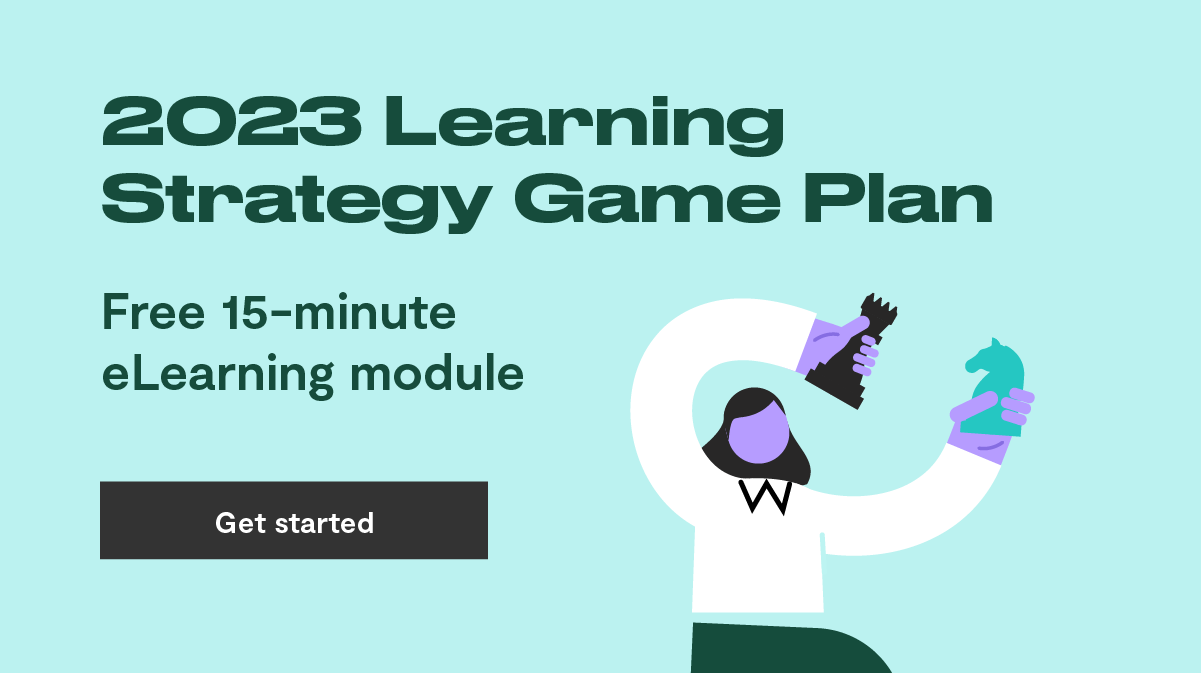5 Slip-Ups Managers Make when Building an L&D Strategy
With the change-over from one calendar year to the next, comes a fresh perspective and plenty of Learning and Development possibilities.
You might have an existing L&D strategy that needs updating, or maybe you need to start from scratch? We’ve pinned down five common mistakes L&D managers make.
We’ve also got a surprise for you at the end of this article, so jump in and read on!
Contents:
- They don't take time to reflect
- They work in silos
- They don't align to business objectives
- They stay in the 'comfort zone'
- They work with outdated resources

They don’t take time to reflect
How often do you just sit and ponder?
In this fast-paced world, taking the time to pause and reflect might feel like a luxury but there’s great value in taking time to consider your current L&D strategy, learning resource feedback, data and metrics.
People who reflect strengthen their emotional intelligence, making it easier to cope with new challenges that may come their way.
A simple way to get into the habit of doing this is the traffic light reflection:

Red – What hasn’t worked in the past? What do you need to stop doing?
Orange – What might you need extra support on? What are the things that could work if it’s tweaked/adapted?
Green – What are the things you need to start doing, keep doing or accelerate?
There are many other ways to reflect. Find a method that works for you. This Harvard Business Review article has a few reflection methods that may inspire you.

They work in silos
If you plan your department's L&D in isolation, yes you'll have complete control over creating the resources but this takes away from the richness that mahi tahi with other departments adds.
Too many cooks spoil the broth, so having the right stakeholders involved is vital.
We always encourage learners and a few subject-matter experts to be a part of the design process as well. It’s like having Simon Gault, a sous-chef, a food critic and a few diners involved when planning a meal.
LEARN: How to Work with Subject Matter Experts (free online course)
Will it take longer?
Most probably!
But the end-result will more than likely be something completely different than if only the executive chef created it. It may also open the eyes of the chef to what the end-user would love to have.
Involving different stakeholders will not only enrich the process and output, but you’ll get more eyes across it and buy-in from different people in the organisation, who can serve as champions for it later on.

They don’t align to business objectives
Objectives provide a sense of purpose and direction. The L&D team need to make sure learner objectives match the strategic objectives set out by the organisation. If objectives are mismatched it becomes an expensive activity with no purpose.
There needs to be synergy between the learner – and organisational objectives. If your development offerings aren't truly meeting your learners’ needs and objectives, there's a risk of them getting frustrated and feeling there are better opportunities elsewhere.
Remember to also communicate the organisational objectives to the kaimahi. It’s motivating for kaimahi to know how their day-to-day is contributing to the success of the organisation.
We want to make sure that our L&D offering contributes to the organisational objectives, to ensure a ROI. Often times, there’s an imbalance of one over the other.
A way to combat this imbalance is having cascading goals.
This simply means that goals are translated from one level of the organisation through to the next and all the goals are therefore aligned. Almost like terraces where water flows from the top, to each level, until it reaches the bottom.
READ: What are cascading goals? (and how to use them)
Take a moment to reflect on whether there might be an imbalance of objectives within your organisation.
Some organisations want to invest in the organisational objectives only, e.g. developing the hard skills only or to focus purely on compliance.
We want to make sure that we are providing the opportunities to develop those soft skills needed for our kaimahi to be able to navigate this brittle, anxious, non-linear and incomprehensible (BANI) reality we find ourselves in.
Wouldn’t it be great if our people went home at the end of a long workday, feeling inspired and confident in the new skills or knowledge they’ve gained?

They stay in the 'comfort zone'
As with most industries, there are new advances and trends in learning and development. As L&D specialists we need to make sure we stay on top of these, to keep up with developing learner needs.
Don't get stuck in the comfort zone of one type of learning software or solution for instance, if there are more effective and creative ways out there.
We’re not suggesting you create a virtual reality experience, if just a simple ‘how-to’ quick reference pdf will do the trick. It’s about being in tune with how your learners want to consume information.
CASE STUDY: Using Board Games for Employee Induction
If your kaimahi are listening to podcasts while working, why not create a series of podcasts that could serve as a learning solution to one or more of their learning challenges?
Being a lifelong learner includes challenging yourself and stepping out of your comfort zone to find out how best to create learning that’s truly life-changing.

They work with outdated resources
Keeping up to date with the latest L&D trends means you might want to review what you currently have to make sure if it’s still fit for purpose, up-to-date and to identify any gaps.
There's nothing worse than having outdated links, dates, information, legislation or people mentioned in your offering or presenting it in a mode that isn’t fit for purpose or user-friendly.
The user experience should allow the learner to focus on the learning content and not get distracted or frustrated.
Take some time to consider a few of your current L&D resources:
- Your authoring tool and LMS - Do you have any challenges with regards to them and if so, what other options are available out there?
- Your comms - Are people in your organisation informed about the learning that’s available or is there an awareness piece that needs to precede it? Can learners access learning and on-the-job resources in one, user-friendly place?
- Your L&D team - Do you have all the roles that you need covered? If someone is not available, is there another member who can fill their shoes?
It’s one thing knowing what to steer clear of when planning your L&D strategy, but we’ve created a free module to guide you in the process of developing a winning L&D strategy for this year!
About the author
I'm Frieda, lover dad jokes, fairy-tale endings and outdoor adventures with my family. For almost a decade I designed learning solutions for my Science and Biology high-school students. Now my audience includes a variety of learners from different skill levels and organisations. Since joining Inspire Group, every day has been a meaningful experience collaborating with the team and our clients to design learning that is life changing.





